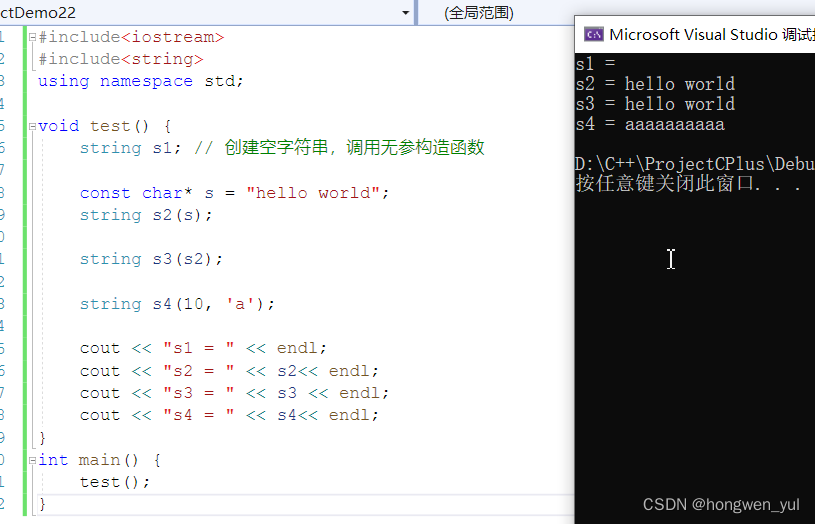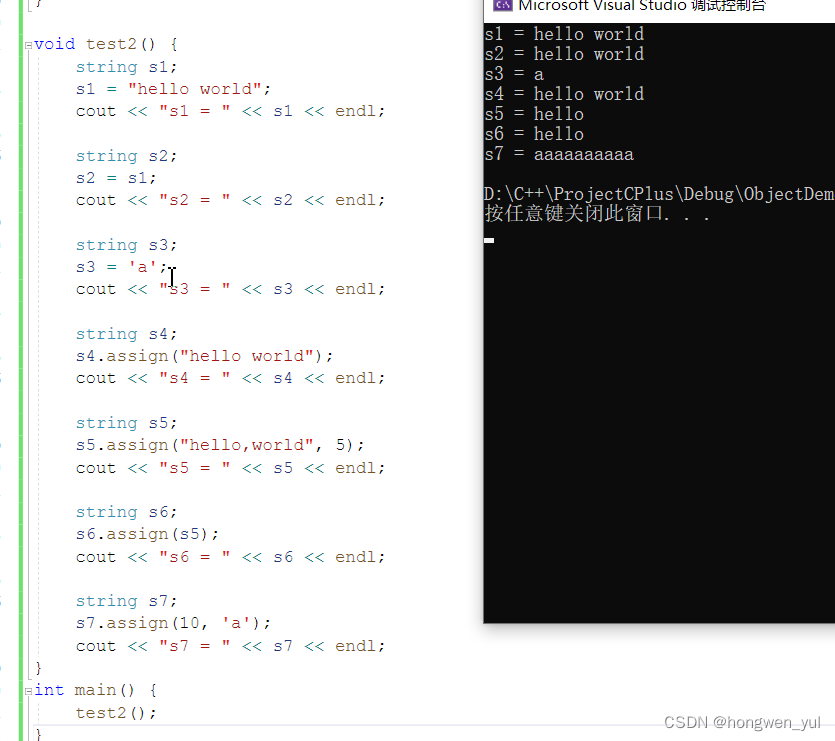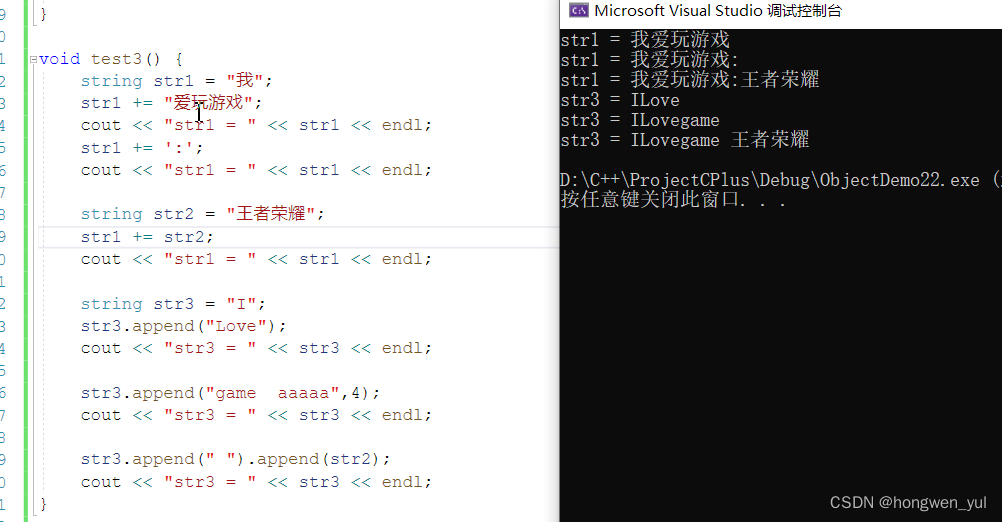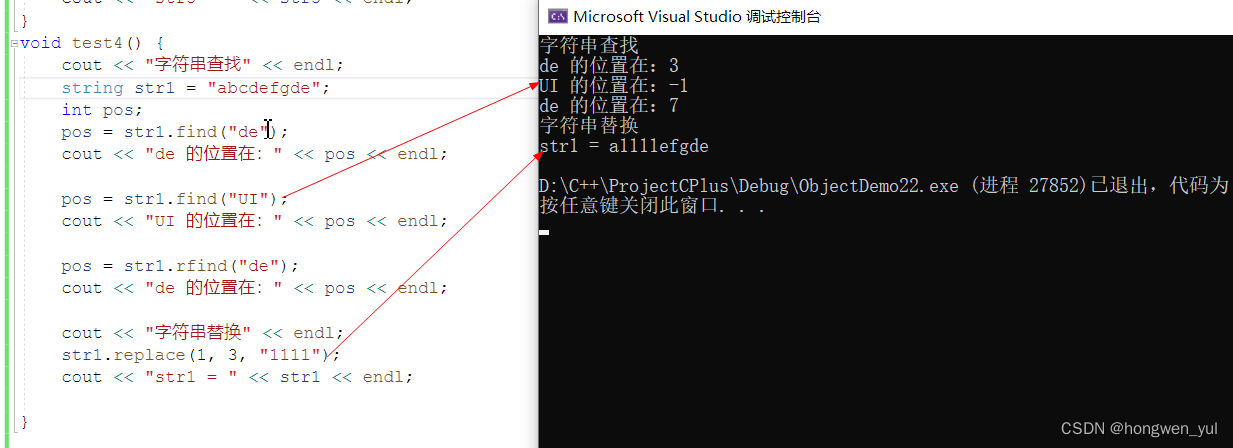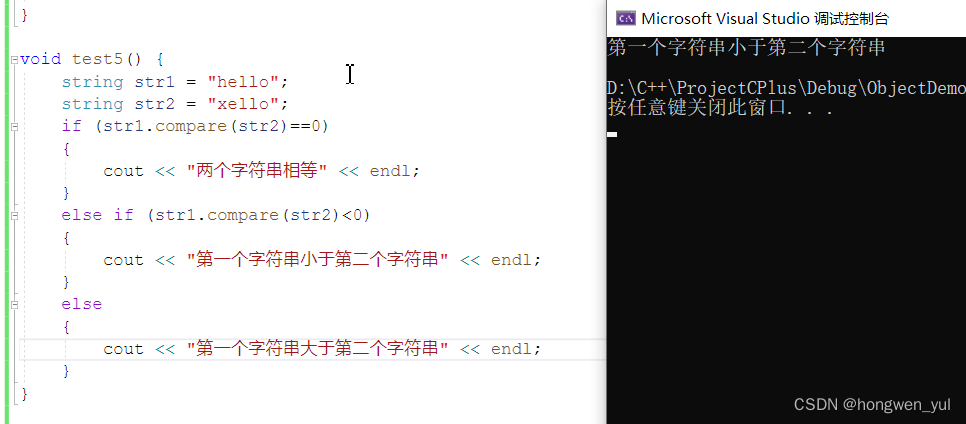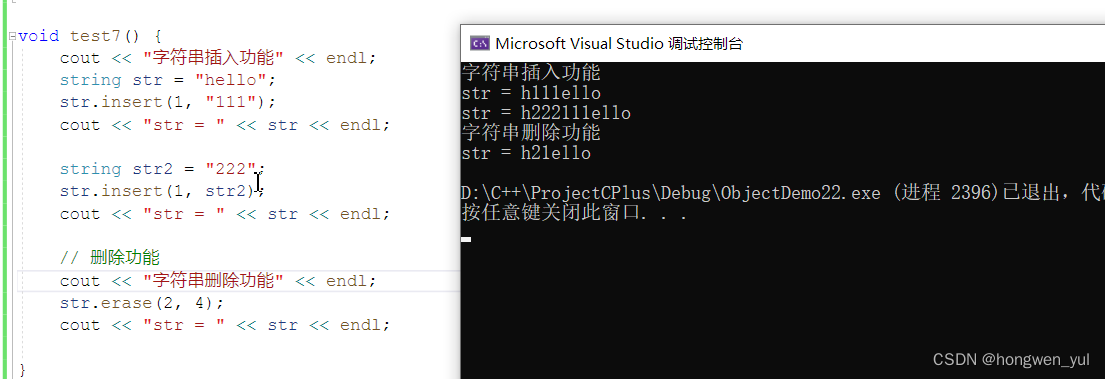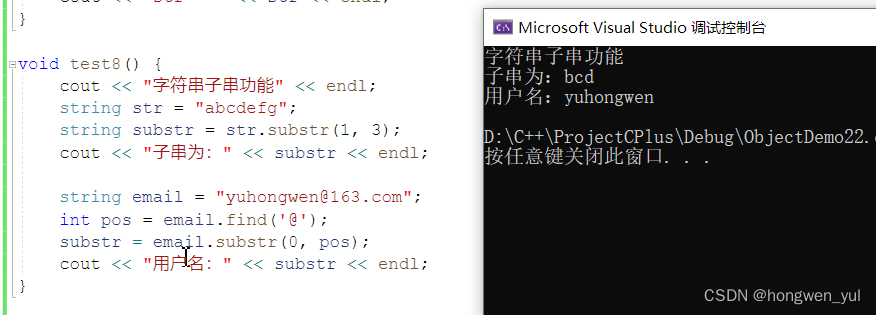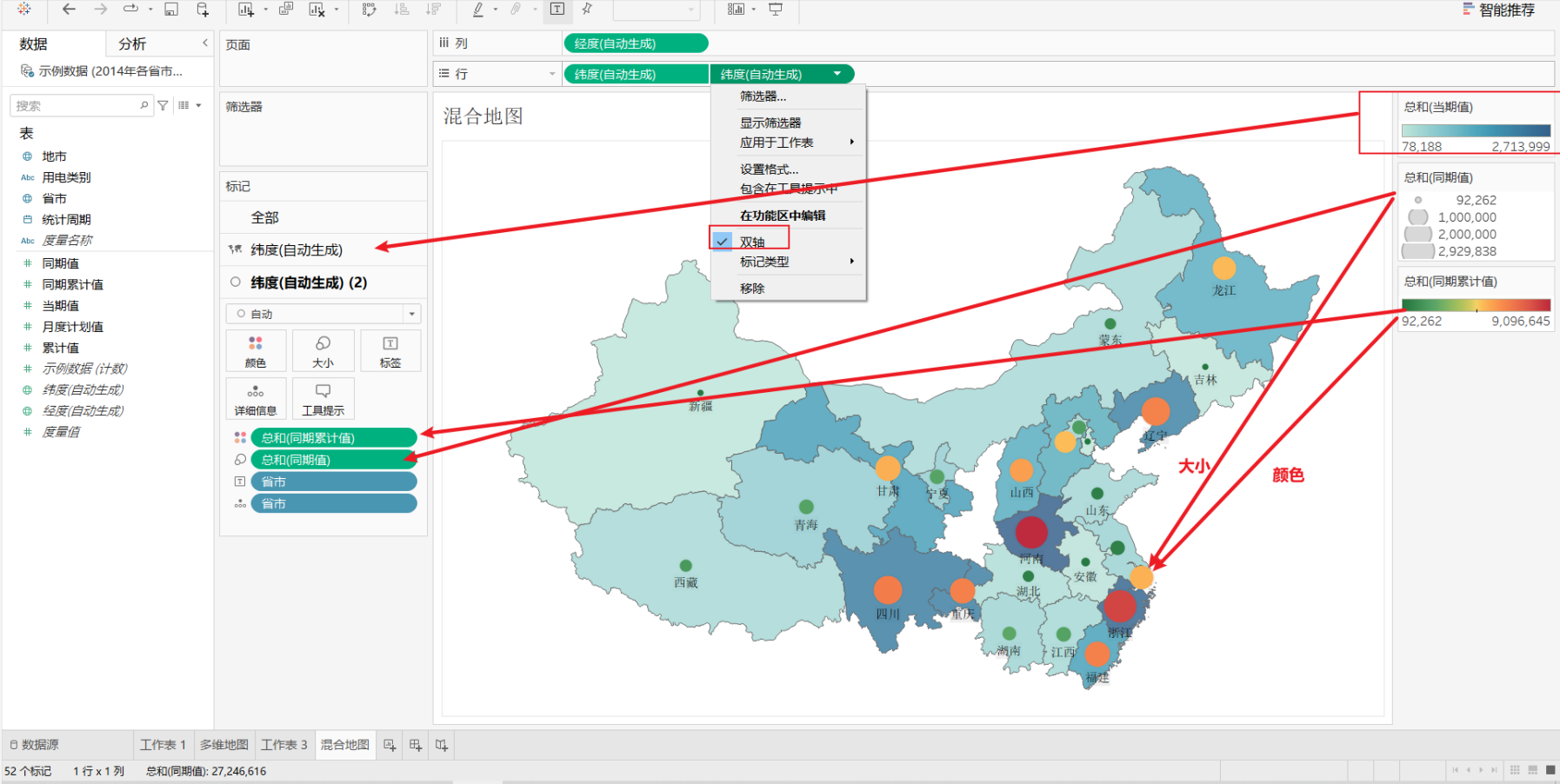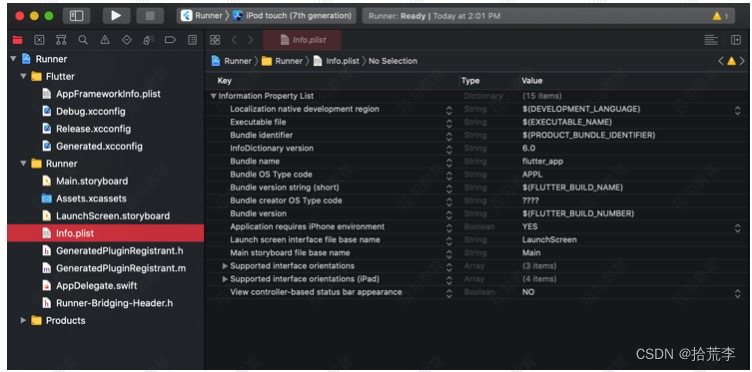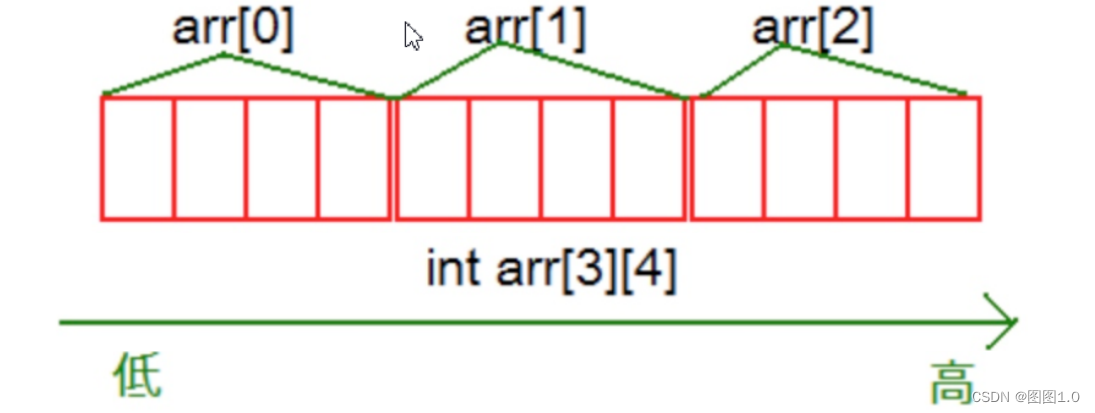1:string容器
1.1 string基本概念
本质: string是C++风格的字符串,而string本质是一个类
string和char* 区别
1:char* 是一个指针
2:string是一个类,类内部封装了 char* 管理这个字符串,是一个 char* 型的容器
特点:
1:string类内部封装了很多成员方法,比如:差找find ,拷贝copy ,删除 delete,替换 replace,插入 insert
2: string管理char* 所分配的内存,不用担心复制越界和取值越界,由类内部进行负责
1.2 string构造函数
string() ------》创建一个空的字符串, string str
string(const char* c) ---->使用字符串 s 进行初始化
string(const string& str) -----》使用一个string对象初始化另一个string对象
string(int n, char c) ----->使用 n个字符 c 初始化
案例:用四种构造函数来实例化 string 对象
#include<iostream>
#include<string>
using namespace std;
void test() {
string s1; // 创建空字符串,调用无参构造函数
const char* s = "hello world";
string s2(s);
string s3(s2);
string s4(10, 'a');
cout << "s1 = " << endl;
cout << "s2 = " << s2<< endl;
cout << "s3 = " << s3 << endl;
cout << "s4 = " << s4<< endl;
}
int main() {
test();
}1.3 :string赋值操作
功能描述:给 string字符串进行赋值
赋值函数原型:
string& operator=(const char* s) // char* 类型字符串赋值给当前的 字符串
string& operator=(const string& s) // 字符串s赋值给当前的字符串
string& operator=(char c) // 字符赋值给当前的字符串
string& assign(const char* s) // 把字符指针s 赋值给当前字符串
string& assign(const char*s ,int n) // 把字符指针前n 个字符,赋值给当前字符串
string& assign(const string& s) // 当字符串s 赋值给当前字符串
string& assign(int n, char c) // 用 n个字符 c 赋值给当前字符串
#include<iostream>
#include<string>
using namespace std;
void test() {
string s1; // 创建空字符串,调用无参构造函数
const char* s = "hello world";
string s2(s);
string s3(s2);
string s4(10, 'a');
cout << "s1 = " << endl;
cout << "s2 = " << s2<< endl;
cout << "s3 = " << s3 << endl;
cout << "s4 = " << s4<< endl;
}
void test2() {
string s1;
s1 = "hello world";
cout << "s1 = " << s1 << endl;
string s2;
s2 = s1;
cout << "s2 = " << s2 << endl;
string s3;
s3 = 'a';
cout << "s3 = " << s3 << endl;
string s4;
s4.assign("hello world");
cout << "s4 = " << s4 << endl;
string s5;
s5.assign("hello,world", 5);
cout << "s5 = " << s5 << endl;
string s6;
s6.assign(s5);
cout << "s6 = " << s6 << endl;
string s7;
s7.assign(10, 'a');
cout << "s7 = " << s7 << endl;
}
int main() {
test();
}1.4:string字符串拼接
功能描述: 实现字符串末尾拼接字符串
函数原型:
string& operator+=(const char* str) // 重载+=操作符
string& operator+=(const char c) // 重载+=操作符
string& operator+=(const string& str) // 重载+=操作符
string& append(const char* s) //把字符串s 连接到当前字符串结尾
string& append(const char* s, int n) // 把字符串s 的前n个字符连接到当前字符串结尾
string& append (const string& s) // 同 operator+=(const string& str)
string& append (const string& s , int pos , int n) // 字符串s ,从pos开始的 n个字符连接到字符串结尾。
#include<iostream>
#include<string>
using namespace std;
void test() {
string s1; // 创建空字符串,调用无参构造函数
const char* s = "hello world";
string s2(s);
string s3(s2);
string s4(10, 'a');
cout << "s1 = " << endl;
cout << "s2 = " << s2<< endl;
cout << "s3 = " << s3 << endl;
cout << "s4 = " << s4<< endl;
}
void test2() {
string s1;
s1 = "hello world";
cout << "s1 = " << s1 << endl;
string s2;
s2 = s1;
cout << "s2 = " << s2 << endl;
string s3;
s3 = 'a';
cout << "s3 = " << s3 << endl;
string s4;
s4.assign("hello world");
cout << "s4 = " << s4 << endl;
string s5;
s5.assign("hello,world", 5);
cout << "s5 = " << s5 << endl;
string s6;
s6.assign(s5);
cout << "s6 = " << s6 << endl;
string s7;
s7.assign(10, 'a');
cout << "s7 = " << s7 << endl;
}
void test3() {
string str1 = "我";
str1 += "爱玩游戏";
cout << "str1 = " << str1 << endl;
str1 += ':';
cout << "str1 = " << str1 << endl;
string str2 = "王者荣耀";
str1 += str2;
cout << "str1 = " << str1 << endl;
string str3 = "I";
str3.append("Love");
cout << "str3 = " << str3 << endl;
str3.append("game aaaaa",4);
cout << "str3 = " << str3 << endl;
str3.append(" ").append(str2);
}
int main() {
test2();
}1.5:string查找和替换
功能描述:
查找: 查找指定字符串是否存在
替换: 在指定的位置替换字符串
函数原型
int find(const string& str , int pos = 0) const // 查找str第一次出现位置,从pos 开始查找
int find(const char* s, int pos = 0) const // 查找s 第一次出现位置,从pos开始查找
int find(const char* s, int pos, int n) const // 从pos位置查找s 的前 n 个字符第一次位置
int find(const char c , int pos = 0) const // 查找字符c 第一次出现的位置
int rfind(const string& str, int pos = npos) const // 查找str 最后一次出现的位置,从pos 开始查找
int rfind(const char* s , int pos = npos) const // 查找 s 最后一次出现的位置,从pos 开始查找
int rfind(const char* s, int pos , int n) const // 从pos位置查找 s 的前n个字符最后一次 出现 位置
int rfind(const char c , int pos = 0) const // 查找字符c最后一次出现位置
string& replace(int pos, int n , const string& str) // 替换从pos位置 开始 n个字符为 字符串 str
string& replace(int pos, int n , const char* s) // 替换从 pos位置 开始的 n 个字符为 字符串 s
注意
find 查找是从左往右, rfind 是从右往左
find 找到字符串后返回查找的第一个字符位置,找不到返回 -1
replace 在替换时,要指定从哪个位置起,多少个字符,替换成什么样的字符串
案例:测试字符串的查找和替换功能
void test4() {
cout << "字符串查找" << endl;
string str1 = "abcdefgde";
int pos;
pos = str1.find("de");
cout << "de 的位置在:" << pos << endl;
pos = str1.find("UI");
cout << "UI 的位置在:" << pos << endl;
pos = str1.rfind("de");
cout << "de 的位置在:" << pos << endl;
cout << "字符串替换" << endl;
str1.replace(1, 3, "1111");
cout << "str1 = " << str1 << endl;
}1.6:字符串比较
功能描述:字符串之间的比较,主要是用于比较两个字符串是否相对,判断谁大谁小的意思 并不是很大。
比较方式:按照字符的 ASCII码逐个进行比较
= :两个祖父串完全相等,返回 0
> : 第一个字符串的首个 字符大于第二个字符串的首个字符,返回 1
< : 第一个字符串的首个字符小于第二个字符串的首个字符,返回-1
函数原型
int compare(const string& s)const // 与字符串s进行比较
int compare(const char* chr) const // 与字符串 chr 进行比较
案例:测试字符串的比较功能
void test5() {
string str1 = "hello";
string str2 = "xello";
if (str1.compare(str2)==0)
{
cout << "两个字符串相等" << endl;
}
else if (str1.compare(str2)<0)
{
cout << "第一个字符串大于第二个字符串" << endl;
}
else
{
cout << "第一个字符串小于第二个字符串" << endl;
}
}1.7 :string字符存取
string单个字符存取方式有两种
char& operator[](int n) // 通过[] 方式取字符
char& at(int n) // 通过at 方式获取字符
void test6() {
string str = "hello";
cout << "取字符串中的字符" << endl;
for (int i = 0; i < str.size(); i++)
{
cout << str[i] << " ";
}
cout << endl;
for (int i = 0; i < str.size(); i++)
{
cout << str.at(i) << " ";
}
cout << endl;
cout << "修改字符串中的字符" << endl;
str[0] = 'x';
str.at(1) = 'x';
cout << "str = " << str << endl;
}1.8 : string插入和删除
功能描述:对 string 字符串进行插入和删除字符操作
函数原型:
string& insert(int pos , const char* chr) // 插入字符
string& insert(int pos, const string& str) // 插入字符串
string& insert(int pos, int n, char c) // 在指定位置插入 n 个字符c
string& erase(int pos , int n = npos) // 删除从 pos开始的n 个字符
案例: 测试字符串的插入和删除功能
void test7() {
cout << "字符串插入功能" << endl;
string str = "hello";
str.insert(1, "111");
cout << "str = " << str << endl;
string str2 = "222";
str.insert(1, str2);
cout << "str = " << str << endl;
// 删除功能
str.erase(2, 4);
cout << "str = " << str << endl;
}1.9 :字符串子串
功能描述: 从字符串中获取想要的字串
函数原型: string substr(int pos = 0,int n = npos)const // 返回由pos开始的 n 个字符组成的字符串
案例:测试字符串字串的功能
void test8() {
cout << "字符串子串功能" << endl;
string str = "abcdefg";
string substr = str.substr(1, 3);
cout << "子串为:" << substr << endl;
string email = "yuhongwen@163.com";
int pos = email.find('@');
substr = email.substr(0, pos);
cout << "用户名:" << substr << endl;
}